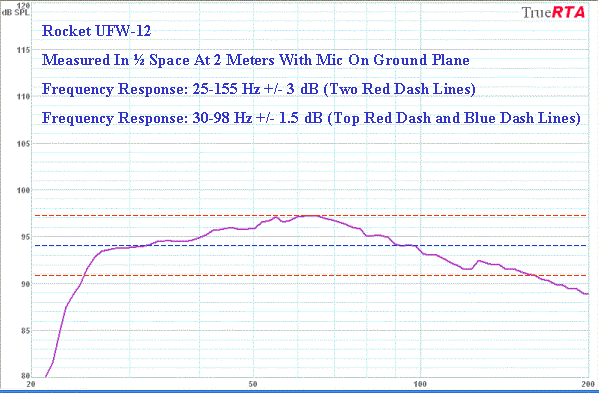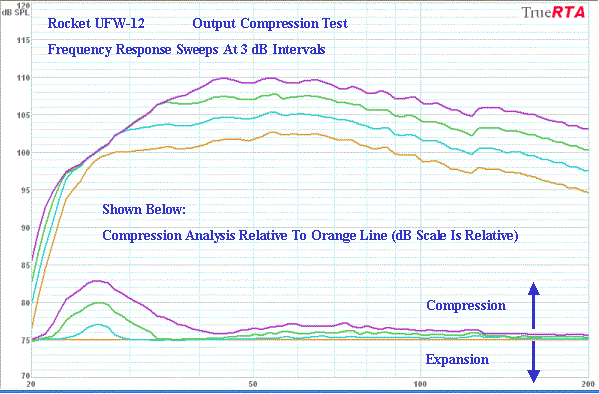On the Bench
Set-Up: All objective tests were conducted outside away from any reflective
structures, with the subwoofer sitting on the ground plane. The microphone
was also placed on the ground plane, facing the woofer at a distance of 2
meters from the width and depth center point of the cabinet. This test
environment will provide a very similar (but not identical) frequency
response as a free air (full space or 4 pi) test environment.
Frequency Response Test: A subwoofer with a flat frequency response will
sound even and linear across the entire pass band. The deeper a
subwoofer can extend, the better it will be able to play pipe organ music,
or the extremely deep special effects found on many action DVDs.
The frequency response was measured with a 45 second logarithmic reverse
sine sweep from 200 Hz to 10 Hz. The output of the sweep was adjusted to 90-95
dB over the majority of the pass band. Data resolution is 1/24 octave with
no smoothing applied. The UFW-12 frequency response measured 25-155 Hz
± 3
dB, and 30-98 Hz ± 1.5 dB.

Output Compression Test: As playback level is increased, any subwoofer will
eventually reach its linear output limits. These limits are usually first
reached at the deepest frequencies. This phenomenon is known as output
compression, and can be caused by exceeding the thermal, mechanical, or port
flow limits of the subwoofer. Output compression can also be caused by
amplifier limiter circuits engaging to prevent subwoofer overload.
The goal of this test is to determine how loud the subwoofer can play before
its frequency response becomes non-linear. It is also useful to assess the
extent and severity of the compression at progressively higher sweep levels.
A subwoofer which remains compression-free at loud sweep levels will sound
powerful and dynamic on demanding music and DVD passages. Conversely, a
subwoofer which exhibits significant compression will have poor dynamics at
high playback levels, with the deepest passages lacking power and impact
relative to the mid-bass passages.
Output compression was evaluated with a 45 second logarithmic reverse sine
sweep from 200 Hz to 10 Hz. Sweeps were conducted at progressively louder (3
dB) increments. The graph below shows each sweep, along with an analysis
which indicates the amount of compression or expansion, relative to the
highest uncompressed sweep level.
The UFW-12 frequency response remained linear (uncompressed) up to the
orange curve. The next three sweeps (blue, green, purple) showed
progressively higher amounts of compression, with the peak centered at 26-27
Hz. The purple curve also showed 1-2 dB of compression across almost the
entire pass band, so the test was terminated at this sweep level.
This compression behavior is normal for a sealed subwoofer. Since cone
excursion requirements quadruple with each successively lower octave,
eventually a sealed subwoofer will exhibit excursion-limited compression at
the deepest frequencies. Still, 100 dB of uncompressed output at 26-27 Hz is
a good performance for a single 12" sealed subwoofer, and the ability to hit
109-110 dB in the 40-70 Hz region is impressive.

Total Harmonic Distortion (THD) Test: Harmonic distortion occurs when
multiples of the fundamental signal are produced by the woofer due to
non-linear (electromotive or mechanical) driver behavior. Most woofers will
exhibit fairly linear output behavior up to about 10% THD. If the woofer is
pushed much past 10% THD, it will quickly become non-linear, with small
increases in sound pressure resulting in disproportionately large increases
in distortion.
The audibility of distortion is a function of the sound pressure and order
of the distortion harmonics relative to the fundamental, and the presence of
any other masking sounds in the source material. Also, odd-order distortion
harmonics are musically dissonant, and are usually perceived as more
objectionable for this reason. While there is debate over distortion
audibility thresholds for deep bass frequencies, my own experience indicates that THD exceeding 10%
will cause audible doubling, a loss of clarity, and noticeable pitch
shifting during normal music and movie playback.
For the aforementioned reasons, I use a 10% THD limit for this test. The
goal is to measure the 10% THD-limited sound pressure at various test
frequencies, and also to assess the linearity of this performance across the
entire pass band. A subwoofer which scores high in both categories will
sound clean and distinct at all bass frequencies (especially the deepest
ones) even at loud playback volumes. Conversely, a subwoofer which scores
lower in one (or both) categories will start to produce audible distortion
harmonics, particularly at the deepest frequencies, as the playback level is
increased.
As shown in the table below, the UFW-12 can play very loud at/above 40 Hz
before distortion reaches 10%. In fact, this is one of the strongest overall
performances in the 40-80 Hz bandwidth I have yet measured. At some mid-bass
test frequencies, the output was capped by the amplifier limiter before
distortion reached 10%. Distortion limited output dropped off quickly below
32 Hz, and was further exacerbated by the high pass filter, which is
designed to sharply reduce output below 23 Hz to help protect the woofer
from over-excursion. The UFW-12 obviously isn't designed to play at 20 Hz,
so I omitted that test frequency.
| Frequency (Hz) |
SPL (dB) |
THD (%) |
| 22 |
85.7 |
10.1 |
| 25 |
93.3 |
10.2 |
| 32 |
102.2 |
10.0 |
| 40 |
109.2 |
7.1* |
| 50 |
110.0 |
7.4* |
| 63 |
110.3 |
10.2 |
| 80 |
109.2 |
9.5* |
* output was capped by the amplifier
limiter before THD reached 10%
Output linearity (with respect to the 10% THD limits shown above) is
calculated by dividing the average SPL by the maximum SPL, and expressing
the result as a percentage. A score of 100% means the subwoofer exhibits
perfect output linearity (with respect to the 10% THD limits) across a given
bandwidth.
As shown in the table below, the UFW-12 delivers loud average sound pressure
levels in the 25-80 Hz and 32-80 Hz bandwidths. The bandwidth linearity
score is very good from 25-80 Hz, and excellent from 32-80 Hz, which is in
keeping with the design goals for this subwoofer.
| Bandwidth (Hz) |
Average SPL (dB) |
Bandwidth Linearity |
| 22-80 |
102.8 |
93% |
| 25-80 |
105.7 |
96% |
| 32-80 |
108.2 |
98% |
Click Here to Go to Part
V.